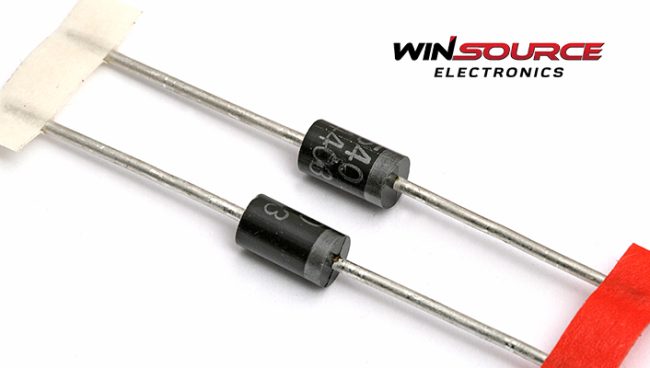
Schottky Diode Voltage
Forward Voltage:
The forward voltage drop across a Schottky diode is significantly lower than that of a standard p-n junction diode. This low forward voltage is a result of the metal-semiconductor junction, allowing for reduced conduction losses and increased efficiency in power electronics applications.
Reverse Voltage:
While Schottky diodes exhibit excellent forward voltage characteristics, they are sensitive to reverse voltage. This section explores the impact of reverse voltage on the diode’s performance and the importance of selecting an appropriate diode configuration to mitigate reverse voltage stress.
Diode Configuration
Single Diode Configuration:
In power electronics circuits, Schottky diodes are commonly employed in a single diode configuration for rectification purposes. This section discusses the advantages and limitations of using a single diode and provides insights into optimizing the diode selection for specific applications.
Dual Diode Configuration:
To address the limitations of a single diode, a dual diode configuration is often employed. This configuration enhances the rectification process and minimizes reverse recovery losses. The article explores the intricacies of dual diode configurations and the trade-offs involved.
Performance Parameters
Average Rectified Current:
The average rectified current is a critical parameter in power electronics applications, determining the effective power delivery. This section explains the relationship between the average rectified current and the diode’s forward voltage drop, offering insights into optimizing circuit efficiency.
Peak Forward Surge Current:
Schottky diodes are known for their fast switching speed, making them suitable for high-frequency applications. The peak forward surge current is a crucial parameter in dynamic scenarios, and the article provides a detailed analysis of its impact on diode performance.
Reverse Leakage Current:
Reverse leakage current is an inherent characteristic of Schottky diodes and can impact circuit efficiency. This section explores the factors influencing reverse leakage current and strategies to minimize its effects through proper diode selection and circuit design.
Dynamic Modeling and Simulation
The dynamic model of a Schottky diode involves capturing its transient response to changes in voltage and current, considering factors like reverse recovery time and parasitic capacitances. Simulation tools allow engineers to analyze the diode’s behavior under various operating conditions, aiding in the identification of potential issues and the refinement of circuit designs.
These simulations provide insights into dynamic phenomena, such as voltage spikes and switching losses, helping engineers optimize circuit layouts and select suitable components. Additionally, dynamic modeling facilitates the evaluation of Schottky diodes in complex power electronic systems, ensuring their compatibility and reliability in real-world applications.
As power electronics applications continue to evolve, the ability to simulate and model Schottky diodes dynamically becomes increasingly important. This approach not only accelerates the development process but also contributes to the creation of more efficient and reliable power electronic systems for diverse industrial and consumer applications.
Dynamic Capacitance and Charge Storage:
The dynamic capacitance of Schottky diodes plays a crucial role in their switching behavior. As voltage varies, the dynamic capacitance changes, impacting the time it takes for the diode to switch states. This phenomenon influences the overall performance of electronic circuits employing Schottky diodes, especially in high-frequency applications.
Additionally, exploring charge storage effects during forward and reverse bias conditions is essential. During forward bias, charge storage can affect the diode’s turn-off characteristics, while reverse bias conditions involve the depletion of stored charge, influencing the turn-on behavior.
Temperature Dependence and Thermal Considerations:
Temperature variations significantly affect Schottky diode performance. Analyzing these influences is vital for designing reliable circuits. Higher temperatures generally result in increased leakage currents and decreased forward voltage drops, impacting the diode’s efficiency.
Addressing thermal considerations is crucial for optimal operation. Strategies for effective heat dissipation, such as incorporating heat sinks or choosing appropriate packaging, become essential to maintain stable performance and prevent thermal degradation.
Transient Analysis of Switching Speed:
Conducting a transient analysis provides insight into the switching speed dynamics of Schottky diodes. Understanding how quickly the diode transitions between its on and off states is critical for evaluating circuit efficiency. The impact of switching speed extends to potential trade-offs, as faster switching can enhance overall circuit performance but may also introduce challenges such as increased power dissipation and electromagnetic interference.
Reverse Recovery Phenomenon:
The reverse recovery phenomenon in Schottky diodes is a critical aspect affecting their usage in power electronics circuits. During the transition from forward to reverse bias, there’s a brief period where the diode takes time to fully block the current flow, resulting in reverse recovery losses. Examining this phenomenon is essential to optimize circuit performance.
Proposing methods to mitigate reverse recovery losses, such as incorporating snubber circuits or carefully selecting diode characteristics, becomes crucial for enhancing the overall efficiency of power electronics circuits employing Schottky diodes.
All in all, through sophisticated simulation techniques and dynamic modeling approaches, researchers can gain valuable insights into the transient behavior, thermal effects, and overall performance of Schottky diodes in power electronics circuits. This knowledge enables engineers to make informed decisions during the design phase, leading to more reliable and efficient power electronic systems.
If you need top-notch diodes or other components, platforms such as WIN SOURCE, a reputable distributor that deals in a variety of electronic components.
© 2025 Win Source Electronics. All rights reserved. This content is protected by copyright and may not be reproduced, distributed, transmitted, cached or otherwise used, except with the prior written permission of Win Source Electronics.

COMMENTS